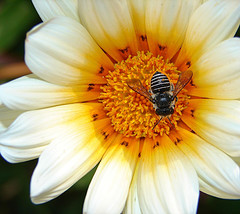 Last year, Häagen-Dazs announced it would invest a quarter of a million dollars into research on “Colony Collapse Disorder” — the mysterious ongoing disappearance of millions of honeybees in North America and Europe. Is this mere corporate greenwashing, or does the premium ice cream icon deserve our affection (and our business)?
Last year, Häagen-Dazs announced it would invest a quarter of a million dollars into research on “Colony Collapse Disorder” — the mysterious ongoing disappearance of millions of honeybees in North America and Europe. Is this mere corporate greenwashing, or does the premium ice cream icon deserve our affection (and our business)?
Häagen-Dazs has a vested interest in preserving and rescuing honeybees, since nearly 40% of their flavours rely on fruits and nuts pollinated by bees. But we shouldn’t dismiss this as mere self-serving business interests. If anything, we should wonder why this sort of investment is not much more common.
Protecting Self-Interests = Good for the Planet?
Any business wants to protect its own interests. When protecting those interests would encroach on the rights of other companies or individuals, that’s an obvious ethical problem: corporate greed going too far. But this isn’t what’s happening here.
The entire environmental movement could be argued to be “protecting its own interests” in the same way that corporations do. We want to ensure that our planet is still around for our children, that we have a healthy environment in which to live and work. It is not just a purely noble and self-sacrificial goal, for the sake of the biosphere itself, whatever the fate of humanity. Ideally, we want to preserve ourselves as well. If businesses take environmental actions motivated by the desire to preserve their own futures, this is not something we should criticize.
Too many corporations are so blinded by the lure of immediate profit, they fail to recognize that mismanagement of natural resources will inevitably lead to the collapse of their industries. If businesses stopped being so short-sighted, and began to realize that investing in the “green economy” would benefit their bottom line in the long run, just imagine the changes we would see.
Häagen-Dazs Loves Honeybees
Häagen-Dazs is doing more than just throwing money at the problem. Through their “Häagen-Dazs Loves Honeybees” program, they are actively promoting awareness of the honeybee CCD issue through community education programs and a special edition flavour, Vanilla Honey Bee. They landscape their offices and plants with bee-friendly flowers, and give their employees free seeds to encourage home gardening. Their Help the Honeybees website provides information on CCD and bee-friendly gardening, lists links to other useful websites, and encourages us to support beekeepers by purchasing locally-produced honey and beeswax products.
So Häagen-Dazs is being proactive and behaving responsibly in response to an environmental crisis that would negatively affect their business. Plus, unlike most commercial ice creams, they use real milk and cream rather than “modified milk ingredients.” So it sounds perfect – a frozen treat you can feel good about sharing with your children.
Unfortunately, it’s not that simple.
Häagen-Dazs and the Nestle Boycott
In 2001, Häagen-Dazs was absorbed by Nestle in the US and Canada. Nestle is still under criticism for its continued unethical marketing of infant formula in violation of the International Code of Marketing of Breastmilk Substitutes, apparently deliberately seeking to undermine breastfeeding around the world in order to sell more formula. If you have chosen to participate in the Nestle Boycott, you now have a catch-22. Should you buy Häagen-Dazs in order to support and applaud responsible business practices? Or avoid it in order to protest some of the most wantonly and unapologetically unethical business practices around?
Unfortunately, I don’t have an easy answer for you. Like so many ‘green’ decisions we face, there are pros and cons to both sides. CFL’s save energy but use mercury. Cloth diapers stay out of landfills, but use more water, detergents and electricity. Often, the benefits of one choice obviously outweigh the drawbacks, so the decision is relatively simple. Sometimes, though, it’s just not so clear-cut.
[This post was written by Heather Dunham]
Photo by aussiegall at flickr.com under Creative Commons
I can’t believe that Nestle is still pulling that crap! I remember in the 70’s, as a child, boycotting Nestle because of the formula issue. It is not only an issue of whether breast milk is better, many places do not have clean water to mix the formula with and babies die! So I will be sticking to Ben and Jerry’s and Stony Field for dessert. However, as a lover of Haagen Dazs’s mint chip, I am still curious about where they get their milk. I know they care about the bees but do they care about the cows? Does anyone know about where their milk comes from?
Thanks!
Haagen Dazs is at home within the confines of Nestle. Haagen Dazs sources its products from China, including milk made form cows that have been contaminated with rbst and antibiotics. Aside from the fact that the cows suffer excruciating pain during their lives due to mastitis, consumers are made sick by the chemicals (and the infected cow pus that is transferred from the utters to the milk).
You would have to be crazy to eat the stuff. Europe, Canada, Japan and 27 other countries have banned rbst as it causes early puberty, cervical and testicular cancer.
Do you really expect a company like Nestle to do the right thing? Please!!